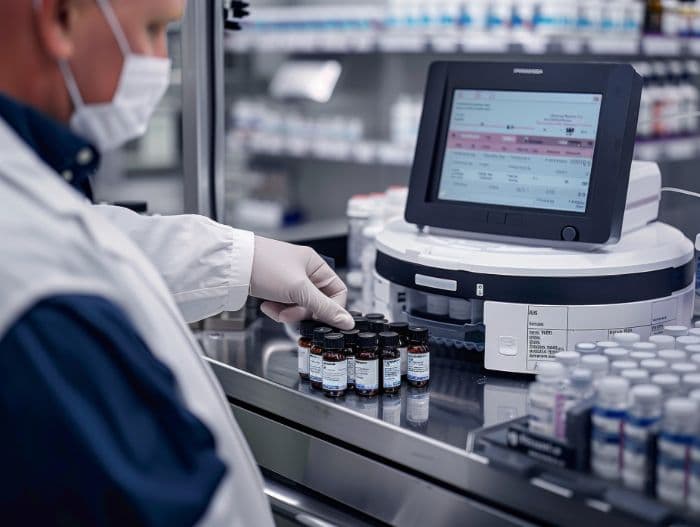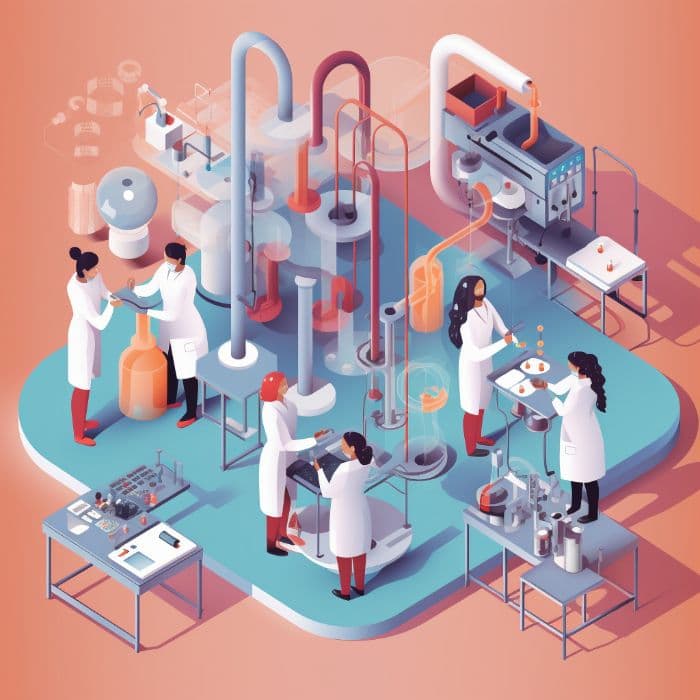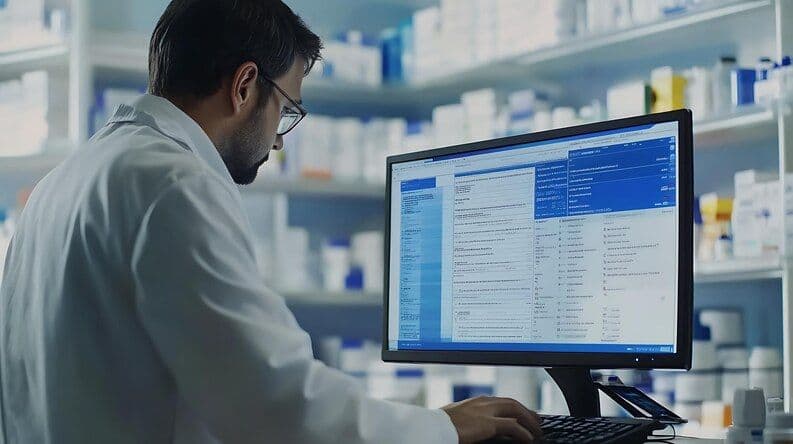In recent years, tariffs that were once negligible in pharma logistics have surged; for example, the U.S. and EU have imposed steep 25% duties on each other’s pharmaceutical exports, ending decades of tariff-free trade for critical medicines and supplies crucial to the industry.
Simultaneously, the Harmonized Tariff Schedule (HTS) codes used to classify products at customs have come under greater scrutiny. Misusing or misclassifying HTS codes can now trigger shipment delays, surprise fees, and even legal penalties.
Together, these changes are pushing pharma companies to navigate higher costs for raw materials, lab equipment, and critical supplies, while also increasing compliance risks during transit.
This article explores how these tariff changes and HTS code complexities are reshaping pharma supply chains and what logistics leaders should do to protect their margins in 2025.
Table of Contents:
- What Is an HTS Code?
- Tariff Impact on Pharmaceutical Manufacturing in 2025
- HTS Code Descriptions and the Risks of Misclassification
- Key HTS Exemptions Every Pharma Team Should Know
- The Hidden Cost of Internal Parcel Shipping
- Key Takeaways
- Conclusion + Actionable Advice for Ops Teams
- Frequently Asked Questions about Pharma Supply Chains & HTS Codes
What Is an HTS Code?
An HTS (Harmonized Tariff Schedule) code is a 10-digit numerical identifier used by U.S. Customs to classify goods and determine import duties. While the first six digits align globally under the HS (Harmonized System), the last four are specific to the United States, setting precise tariff rates and tracking statistics.
HS Codes vs HTS Codes in Pharma Logistics
The distinction between HS codes and HTS codes is critical in pharma logistics. HS codes standardize international trade, while HTS codes provide granular details necessary for U.S. import processes. Pharma teams frequently interact with both codes, impacting tariffs, customs clearance, and regulatory compliance.
Confusion between HS and HTS codes can have serious consequences in pharma logistics. An incorrect HTS code can result in paying the wrong (usually higher) duty or violating customs regulations. For instance, classifying a specialized pharmaceutical ingredient under a generic chemical HS code might incur a tariff that could have been avoided.
In clinical supply chains, delays at customs due to a code error can disrupt time-sensitive drug shipments. In fact, customs experts note that misclassified HTS codes frequently lead to shipment delays, fines, or even seizures of goods, scenarios no pharma company wants when delivering critical medicines.
Tariff Impact on Pharmaceutical Manufacturing in 2025
The tariff environment for pharmaceuticals has changed dramatically, and 2025 finds many pharma supply chains caught in the crossfire of trade disputes and protectionist policies. Global tariffs that barely touched pharma a few years ago are now hitting essential materials, forcing companies to adapt or absorb higher costs.
A prime example is the ongoing U.S. trade tensions with major partners. In a sharp departure from nearly 30 years of largely duty-free pharmaceutical trade, the U.S. recently implemented broad tariffs on imports that now affect active pharmaceutical ingredients (APIs), excipients, packaging, and equipment.
Indeed, the added import taxes on APIs and raw materials are “significantly increasing the cost” to make drugs in the U.S., an increase ultimately passed to patients or absorbed in manufacturers’ margins.
Beyond higher costs, tariffs are also introducing operational uncertainty and complexity. Pharma companies now must monitor a fluctuating landscape of trade policies. Sudden tariff hikes or new duties on a critical ingredient can throw off sourcing strategies and budgets.
There’s also the risk of retaliatory measures between countries, which can rapidly change market access. This volatile environment has put the industry on edge: manufacturers are exploring contingency plans like qualifying second-source suppliers in no-tariff countries, increasing inventory of tariffed components, or even leveraging analytics tools to identify inefficiencies and cost-saving opportunities in parcel-level shipping.
HTS Code Descriptions and the Risks of Misclassification
Misclassification means assigning the wrong HTS code to a product, whether by mistake or in an attempt to use a “better” (lower duty) code. The risks of misclassification have never been higher. Customs authorities worldwide are on high alert for incorrect HTS codes because misclassification can be used to evade tariffs.
High-profile enforcement cases underline the stakes: in one 2023 case, a U.S. importer faced a $22.8 million settlement for misclassifying vitamins and supplements under incorrect HTS codes to avoid tariffs. Conversely, using a code that’s too low (e.g., treating a product as a research sample when it’s really a commercial shipment) will backfire when customs bills the difference with interest.
Another hidden risk of misclassification is missed opportunities for duty relief. HTS codes not only determine when you pay more, but they can also determine if you could pay less. There are special HTS provisions (discussed in the next section) that waive tariffs for qualifying shipments like samples or prototypes. If a team isn’t aware of them and uses a generic code instead, they might be unnecessarily paying duties that could have been avoided.
In other cases, trade agreements or pharmaceutical-specific exemptions might zero out the tariff on a product, but only if it’s classified correctly to meet the criteria. In sum, precision in HTS coding is now a required discipline. The costs of misclassification, be it direct penalties, unnecessary duties, or supply chain delays, are simply too high to ignore.
Key HTS Exemptions Every Pharma Team Should Know
The U.S. Harmonized Tariff Schedule contains special classifications in Chapter 98 that allow certain goods to enter duty-free or at reduced rates under specific conditions. Here are three key HTS exemptions particularly relevant to pharmaceutical logistics, along with why they matter:
HTSUS 9811.00.60 – Commercial Samples:
This provision covers bona fide samples that are not for resale, and it allows them to be imported duty-free. The code 9811.00.60 is described as “Any sample … valued not over $1 each, or marked, torn, perforated, or otherwise treated so that it is unsuitable for sale”.
In practice, there are two ways a sample qualifies: either its value is truly negligible (≤ $1) or it’s been physically marked or mutilated (for example, a pill bottle with holes drilled in it, or a device with a “sample” stamp) to ensure it can’t be sold.
For pharma teams, leveraging this sample exemption means, for example, clinical trial samples or materials for lab testing can enter the U.S. without incurring tariffs, as long as they meet the marking and usage rules.
HTSUS 9817.85.01 – Prototypes for Research and Development:
This is a valuable but sometimes overlooked provision that allows duty-free import of prototypes to be used exclusively for product development, testing, or quality control. The U.S. created subheading 9817.85.01 specifically to encourage innovation.
Under this rule, a wide range of articles can qualify as prototypes: they can be early-stage versions of new drugs or medical devices, laboratory apparatus, or any experimental materials not yet in general production.
It’s worth noting that once the testing is done, the prototype can be re-exported, scrapped, or retained for further R&D, but it generally should not be sold commercially without notifying customs and paying duties at that point.
HTSUS 9813.00.XX – Temporary Importation Under Bond (TIB):
Sometimes a pharma company needs to import something temporarily, not to consume or sell it, but to use it for a specific purpose and then send it back out. The Temporary Importation Under Bond program, often referred to simply as TIB, covers this scenario.
Tariff numbers 9813.00.05 through 9813.00.75 encompass various categories of goods that can enter the U.S. without duty under a bond, as long as they are re-exported or destroyed within a specified timeframe (usually up to 1 year, extendable to 3).
In the context of pharma, TIB entries might be used for things like scientific instruments or medical devices brought in for a trade show or conference, or investigational drugs imported for a clinical trial and then sent back to the manufacturer.
Under a TIB, the importer posts a bond (often equal to double the would-be duty) as a financial guarantee and then recovers it when the goods exit the country again. No duty is paid as long as the conditions are met.

The Hidden Cost of Internal Parcel Shipping
Modern pharmaceutical organizations are often large, multi-site operations with global footprints. It’s common for a company’s own facilities to ship materials to each other, a plant sends an active ingredient to another plant overseas for formulation, or the R&D center ships experimental samples to a manufacturing site.
These are not sales or customer shipments, just internal logistics. Because of that, they can fly under the radar of cost control and compliance oversight. However, there are significant hidden costs and risks lurking in this internal parcel shipping that pharma teams must address.
Common Errors and Their Consequences
One hidden cost is inefficiency and lack of coordination. Internal shipments are sometimes arranged ad hoc by individual departments. A scientist needs a compound quickly, so they FedEx it; a manufacturing site runs short of a component, so another site sends stock using an overnight carrier service.
Without a central system, these “quick fixes” can multiply. You might end up with redundant shipments (because one team didn’t know another had already sent materials), or you fail to consolidate shipments that could have been sent in one batch.
The result is inflated transportation costs. Paying express parcel rates for numerous individual packages is far more expensive than a consolidated shipment, yet it happens in many pharma companies because internal logistics often lacks the tight control applied to outbound distribution.
And when shipping urgently, companies may opt for premium services routinely, again driving up cost that doesn’t directly show up in product COGS but hits the bottom line nonetheless.
Operational Complexity and Productivity Drain
Internal parcel shipping adds operational complexity that can indirectly reduce productivity across teams. Even domestic shipments between company sites often require manual coordination, documentation, and follow-up. Without a centralized system, each shipment may involve back-and-forth emails, scattered tracking, and unnecessary administrative work.
When dozens of scientists, lab managers, or supply chain coordinators spend time preparing shipping forms, confirming delivery, or reviewing invoices (time that could be spent on higher-value tasks), it adds up to a significant productivity drain.
Many pharma organizations are now evaluating solutions to automate internal shipping workflows, reduce back-office overhead, and unify visibility across departments. Platforms designed for centralized parcel management can help standardize processes, minimize delays, and ensure compliance without relying on ad hoc fixes.
Key Takeaways
- Tariffs on pharmaceuticals have increased sharply, raising costs for APIs, raw materials, and equipment.
- Misclassifying HTS codes can result in shipment delays, unexpected fees, and penalties.
- Pharma teams can reduce costs using HTS exemptions for samples, R&D prototypes, and temporary imports.
- Internal shipping inefficiencies inflate costs; centralized parcel management can help.
- Operations teams should closely monitor tariffs, accurately classify HTS codes, and optimize shipping processes.
Conclusion + Actionable Advice for Ops Teams
Navigating tariffs and HTS complexities is crucial for maintaining resilient and cost-effective pharma supply chains. Operations teams must prioritize accurate US HTS code classification, proactively monitor tariff changes, and strategically utilize duty-saving exemptions.
Yet one area often overlooked is internal shipping visibility, an issue we've explored throughout this article. Fragmented carrier accounts, lack of spend oversight, and time-consuming invoice processes are quietly driving up operational costs.
As pharma companies scale operations across multiple sites and vendors, gaining full visibility into parcel spend can unlock meaningful savings and reduce administrative burden.
If you're looking to optimize parcel shipping processes, reduce back-office workload, and gain clarity into your shipping operations, reach out to our team through our contact form to request a demo presentation and learn how Airpals can support your pharma supply chain strategy.

Frequently Asked Questions about Pharma Supply Chains & HTS Codes
What is pharmaceutical supply chain?
A pharmaceutical supply chain is the system that manages the production, storage, and delivery of medicines. It includes sourcing raw materials, manufacturing drugs, and distributing them to patients, ensuring safety, compliance, and timely access.
What is HTS code?
An HTS code is a 10-digit classification used by U.S. Customs to determine tariffs on imported goods. In pharma, it ensures accurate duty payments and compliance during international shipping.
How do HTS codes affect pharma supply chains?
HTS codes impact pharmaceutical logistics by determining tariff costs and customs clearance speed. Misclassification can cause delays, fines, or overpayment, affecting overall supply chain efficiency and compliance.
Are there HTS exemptions for pharmaceutical products?
Yes. U.S. Customs offers HTS exemptions for pharmaceuticals, including duty-free entry for samples, R&D prototypes, and temporary imports, helping reduce costs when applied correctly.




